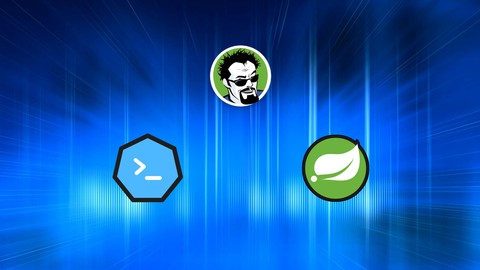
Kube By Example – Spring Boot on Kubernetes
Kube By Example – Spring Boot on Kubernetes, available at Free, has an average rating of 4.7, with 16 lectures, based on 132 reviews, and has 6932 subscribers.
You will learn about Learn How to Deploy a Spring Boot Application on Kubernetes Create a Kubernetes Service for Your Spring Boot Application Start and Stop Your Spring Boot Application on Kubernetes Configure Spring Boot Actuator for Kubernetes This course is ideal for individuals who are Java and Spring Developers who wish to deploy their Spring Boot Application under Kubernetes It is particularly useful for Java and Spring Developers who wish to deploy their Spring Boot Application under Kubernetes.
Enroll now: Kube By Example – Spring Boot on Kubernetes
Summary
Title: Kube By Example – Spring Boot on Kubernetes
Price: Free
Average Rating: 4.7
Number of Lectures: 16
Number of Published Lectures: 16
Number of Curriculum Items: 16
Number of Published Curriculum Objects: 16
Original Price: Free
Quality Status: approved
Status: Live
What You Will Learn
- Learn How to Deploy a Spring Boot Application on Kubernetes
- Create a Kubernetes Service for Your Spring Boot Application
- Start and Stop Your Spring Boot Application on Kubernetes
- Configure Spring Boot Actuator for Kubernetes
Who Should Attend
- Java and Spring Developers who wish to deploy their Spring Boot Application under Kubernetes
Target Audiences
- Java and Spring Developers who wish to deploy their Spring Boot Application under Kubernetes
Kubernetes is a container orchestration system used to automate software deployment, scaling and management.
Effectively, Kubernetes is a management tool direct the running of Docker images.
Kubernetes is actually much more than just a tool to run a Docker image.
However in this course, we will be running a single Docker image under Kubernetes. You will learn how to deploy a simple Spring Boot application (in a Docker image) under Kubernetes.
The course uses a publically available Docker Image. The image contains a Spring Boot Application, which exposes a simple RESTful API.
After learning how to set up a local Kubernetes environment for development, you will learn how to create a Kubernetes Deployment. A Deployment is how Kubernetes defines a Docker container to run.
Next you will learn how to configure a Kubernetes Service. A Service is how you direct Kubernetes to expose deployments to network resources.
Spring Boot has added features to support running in a containerized environment. Two of these are Readiness and Liveness probes.
The Readiness probe accounts for startup period of an application. Once the application has started and is ready for work, the Readiness probe will return a positive result.
The Liveness probe returns a positive result while the application is in a healthy state. Kubernetes can monitor the Liveness probe for application health.
Finally in the course, you will learn to configure a graceful shutdown. This allows the Spring Boot application to complete any inprocess transactions before the container is terminated.
If you’re looking to get started running your Spring Boot applications under Kubernetes enroll today!
Course Curriculum
Chapter 1: Introduction
Lecture 1: Course Introduction
Lecture 2: Introduction to Kubernetes by Example
Lecture 3: Setting up Your Development Environment
Lecture 4: Enable Kubernetes Docker Desktop
Chapter 2: Deploy Spring Boot on Kubernetes
Lecture 1: Introduction
Lecture 2: Create Deployment
Lecture 3: Create Service
Lecture 4: Port Forwarding
Lecture 5: Terminating Services and Deployments
Lecture 6: Exposing Services
Lecture 7: Accessing Logs
Lecture 8: Setting Environment Variables
Lecture 9: Readiness Probe With Spring Boot Actuator
Lecture 10: Liveness Probe with Spring Boot Actuator
Lecture 11: Configure Spring Boot for Graceful Shutdown
Lecture 12: Bonus Lecture
Instructors
-
John Thompson • 500,000+ Enrollments Worldwide
Spring Framework Guru – Best Selling Instructor -
Spring Ahead Code Academy
Spring Ahead with Your Career
Rating Distribution
- 1 stars: 1 votes
- 2 stars: 0 votes
- 3 stars: 8 votes
- 4 stars: 40 votes
- 5 stars: 83 votes
Frequently Asked Questions
How long do I have access to the course materials?
You can view and review the lecture materials indefinitely, like an on-demand channel.
Can I take my courses with me wherever I go?
Definitely! If you have an internet connection, courses on Udemy are available on any device at any time. If you don’t have an internet connection, some instructors also let their students download course lectures. That’s up to the instructor though, so make sure you get on their good side!
You may also like
- Best Video Editing Courses to Learn in March 2025
- Best Music Production Courses to Learn in March 2025
- Best Animation Courses to Learn in March 2025
- Best Digital Illustration Courses to Learn in March 2025
- Best Renewable Energy Courses to Learn in March 2025
- Best Sustainable Living Courses to Learn in March 2025
- Best Ethical AI Courses to Learn in March 2025
- Best Cybersecurity Fundamentals Courses to Learn in March 2025
- Best Smart Home Technology Courses to Learn in March 2025
- Best Holistic Health Courses to Learn in March 2025
- Best Nutrition And Diet Planning Courses to Learn in March 2025
- Best Yoga Instruction Courses to Learn in March 2025
- Best Stress Management Courses to Learn in March 2025
- Best Mindfulness Meditation Courses to Learn in March 2025
- Best Life Coaching Courses to Learn in March 2025
- Best Career Development Courses to Learn in March 2025
- Best Relationship Building Courses to Learn in March 2025
- Best Parenting Skills Courses to Learn in March 2025
- Best Home Improvement Courses to Learn in March 2025
- Best Gardening Courses to Learn in March 2025























